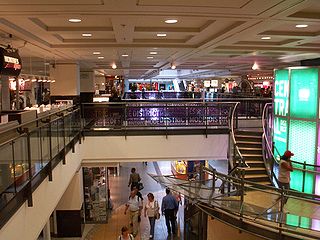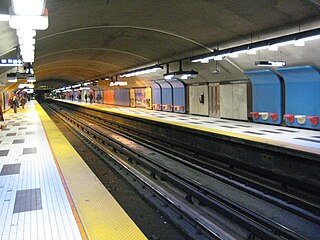
Hector Guimard was a French architect and designer, and a prominent figure of the Art Nouveau style. He achieved early fame with his design for the Castel Beranger, the first Art Nouveau apartment building in Paris, which was selected in an 1899 competition as one of the best new building facades in the city. He is best known for the glass and iron edicules or canopies, with ornamental Art Nouveau curves, which he designed to cover the entrances of the first stations of the Paris Metro.

Porte Dauphine is the western terminus of Line 2 of the Paris Métro. It is situated in the 16th arrondissement. Avenue Foch station, served by the RER C line, is located nearby, as is Paris Dauphine University.

RÉSO, commonly referred to as the Underground City, is the name applied to a series of interconnected office towers, hotels, shopping centres, residential and commercial complexes, convention halls, universities and performing arts venues that form the heart of Montreal's central business district, colloquially referred to as Downtown Montreal. The name refers to the underground connections between the buildings that compose the network, in addition to the network's complete integration with the city's entirely underground rapid transit system, the Montreal Metro. Moreover, the first iteration of the Underground City was developed out of the open pit at the southern entrance to the Mount Royal Tunnel, where Place Ville Marie and Central Station stand today.

Papineau station is a Montreal Metro station in the borough of Ville-Marie in Montreal, Quebec, Canada. It is operated by the Société de transport de Montréal (STM) and serves the Green Line. It is one of two Metro stations that service Montreal's Gay Village, part of the Centre-Sud district. It opened on October 14, 1966, as part of the original network of the Metro. It briefly served as the terminus of the Green Line until Frontenac station opened two months later.

The Orange Line is the longest and first-planned of the four subway lines of the Montreal Metro in Montreal, Quebec, Canada. It formed part of the initial network, and was extended from 1980 to 1986. On April 28, 2007, three new stations in Laval opened making it the second line to leave Montreal Island.

Crémazie station is a Montreal Metro station in Montreal, Quebec, Canada. It is operated by the Société de transport de Montréal (STM) and serves the Orange Line. It is located on the border between the boroughs of Ahuntsic-Cartierville and Villeray–Saint-Michel–Parc-Extension The station opened October 14, 1966, as part of the original Metro network.

Atwater station is a Montreal Metro station in the borough of Ville-Marie in Montreal, Quebec, Canada. It is operated by the Société de transport de Montréal (STM) and serves the Green Line on the border between the city of Westmount and Montreal.

Mont-Royal is a station on the Orange Line of the Montreal Metro rapid transit system, operated by the Société de transport de Montréal (STM). It is located in The Plateau neighbourhood of the borough of Le Plateau-Mont-Royal in Montreal, Quebec, Canada. The station opened on October 14, 1966, as part of the original network of the Metro.

Champ-de-Mars station is a Montreal Metro station in the borough of Ville-Marie in Montreal, Quebec, Canada. It is operated by the Société de transport de Montréal (STM) and serves the Orange Line. It is located in Old Montreal by the Champ de Mars park. It opened on October 14, 1966, as part of the original Metro network.

Place-d'Armes station is a Montreal Metro station in the borough of Ville-Marie in Montreal, Quebec, Canada. It is operated by the Société de transport de Montréal (STM) and serves the Orange Line. It is located in Old Montreal.

Square-Victoria–OACI station is a Montreal Metro station in the borough of Ville-Marie in Montreal, Quebec, Canada. It is operated by the Société de transport de Montréal (STM) and serves the Orange Line. It is located in Victoria Square near the Quartier international de Montréal district. The station opened on February 6, 1967, four months after most of the initial network, and was briefly the terminus of the Orange Line until Bonaventure station was opened a week later.

Place-Saint-Henri station is a Montreal Metro station in the borough of Le Sud-Ouest in Montreal, Quebec, Canada. It is operated by the Société de transport de Montréal (STM) and serves the Orange Line. It is located in the Saint-Henri neighbourhood.

Plamondon station is a Montreal Metro station in the borough of Côte-des-Neiges–Notre-Dame-de-Grâce in Montreal, Quebec, Canada. It is operated by the Société de transport de Montréal (STM) and serves the Orange Line. It is located in the Côte-des-Neiges section of Côte-des-Neiges–Notre-Dame-de-Grâce. It opened on June 29, 1982 and replaced Côte-Sainte-Catherine station as the Orange Line's western terminus until the extension to Du Collège station was completed in 1984.

Namur station is a Montreal Metro station in the borough of Côte-des-Neiges–Notre-Dame-de-Grâce in Montreal, Quebec, Canada. It is operated by the Société de transport de Montréal (STM) and serves the Orange Line. It is located in the Côte-des-Neiges area. This station has a total of 428 parking spaces in two nearby parking lots.

The Quartier international de Montréal (QIM) or Montreal's International District is a district of the Ville-Marie borough in the city's downtown core of Montreal, Quebec, Canada. It is roughly bordered by René-Levesque Boulevard to the north, Notre-Dame Street to the south, De Bleury/Saint-Pierre Street to the east and Robert-Bourassa Boulevard to the west. The Palais des congrès building lying just east of the district is also usually comprised in it. Constructed dispersedly between 1965 and 1985 in place of older colonial housing blocks, the district underwent major urban renewal as a central business district in 2000–2003.

Victoria Square is a town square and public space in the Quartier International de Montréal area of downtown Montreal, Quebec, Canada, at the intersection of Beaver Hall Hill and McGill Street. The Square forms an integral component of the city's urban public transit system and constitutes a 'prestige address' for the international face of the city. It is bordered by Viger Street to the north, Saint Jacques Street to the south, Beaver Hall Hill to the west and Square Victoria Street along the eastern side. As with other city squares, Square Victoria is open 24 hours per day to all citizens of Montreal and provides the role of an urban breathing space, with dense foliage to the south that tapers as the square rises up Beaver Hall Hill.

The Montreal Metro is a rubber-tired underground rapid transit system serving Greater Montreal, Quebec, Canada. The metro, operated by the Société de transport de Montréal (STM), was inaugurated on October 14, 1966, during the tenure of Mayor Jean Drapeau.
Geneviève Cadieux is a Canadian artist known for her large-scale photographic and media works in urban settings.

Complexe Maisonneuve is an office building complex in Montreal, Quebec, Canada. Complexe Maisonneuve is located on De la Gauchetière Street West between University Street and Beaver Hall Hill. It is situated facing Victoria Square in the Quartier international district of Downtown Montreal, and is linked to Montreal's Underground City and Square-Victoria-OACI Station on the Montreal Metro. The complex consists of two buildings, the Tour de la Banque Nationale and 700 de La Gauchetière. It was inaugurated on October 31, 1983. The two towers share an underground base six floors deep.

Between 1900 and 1913, Hector Guimard was responsible for the first generation of entrances to the underground stations of the Paris Métro. His Art Nouveau designs in cast iron and glass dating mostly to 1900, and the associated lettering that he also designed, created what became known as the Métro style and popularized Art Nouveau. However, arbiters of style were scandalized and the public was also less enamored of his more elaborate entrances. In 1904 his design for the Opéra station at Place de l'Opéra was rejected and his association with the Métro ended; many of his station entrances have been demolished, including all three of the pavilion type. Those that remain are now all protected historical monuments, one has been reconstituted, and some originals and replicas also survive outside France.



















